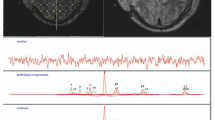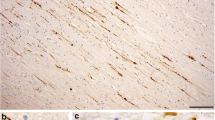Abstract
Purpose
Traumatic brain injury (TBI) causes brain dysfunction in many patients. However, some patients have severe brain dysfunction but display no abnormalities on magnetic resonance imaging (MRI). There have been some reports of hypometabolism even in such patients. The purpose of this study was to investigate the relationship between metabolic abnormality and loss of neuronal integrity in TBI patients with some symptoms but without MRI abnormalities.
Methods
The study population comprised ten patients with TBI and ten normal volunteers. All of the patients were examined at least 1 year after the injury. 15O-labelled gas PET and [11C]flumazenil (FMZ) positron emission tomography (PET) were carried out. The cerebral metabolic rate of oxygen (CMRO2) and binding potential (BP) images of FMZ were calculated. Axial T2WI, T2*WI and FLAIR images were obtained. Coronal images were added in some cases.
Results
All of the patients had normal MRI findings, and all showed areas with abnormally low CMRO2. Low uptake on BP images was observed in six patients (60%). No lesions that showed low uptake on BP images were without low CMRO2. On the other hand, there were 14 lesions with low CMRO2 but without BP abnormalities.
Conclusion
These results indicate that there are metabolic abnormalities in TBI patients with some symptoms after brain injury but without abnormalities on MRI. Some of the hypometabolic lesions showed low BP, indicating a loss of neuronal integrity. Thus, FMZ PET may have potential to distinguish hypometabolism caused by neuronal loss from that caused by other factors.


Similar content being viewed by others
References
Thurman D, Guerrero J. Trends in hospitalization associated with traumatic brain injury. JAMA 1999;282(10):954–7
Sander AM, Kreutzer JS, Rosenthal M, Delmonico R, Young ME. A multicenter longitudinal investigation of return to work and community integration following traumatic brain injury. J Head Trauma Rehabil 1996;11:70–84
Maziere M, Prenant C, Sastre J, Crouzel M, Comar D, Hantraye P, et al. 11C-R[O-15]-1788 et 11C-flunitrazepam, deux coordinats pour l’etude par tomographie par positons des sites de liaison des benzodiazepines. C R Seances Acad Sci III 1983;296(18):871–6
Haglund MM, Berger MS, Kunkel DD, Franck JE, Ghatan S, Ojemann GA. Changes in gamma-aminobutyric and somatostatin in epileptic cortex associated with low-grade gliomas. J Neurosurg 1992;77:209–16
Wolf HK, Roos D, Blumcke I, Pietsch T, Wiestler OD. Perilesional neurochemical changes in focal epilepsies. Acta Neuropathol (Berl) 1996;91:376–84
Rudolf J, Sobesky J, Grond M, Heiss WD. Identification by positron emission tomography of neuronal loss in acute vegetative state. Lancet 2000;355(9198):115–6
Nakagawara J, Sperling B, Lassen NA. Incomplete brain infarction of reperfused cortex may be quantitated with iomazenil. Stroke 1997;28(1):124–32
Heiss WD, Graf R, Wienhard K. Relevance of experimental ischemia in cats for stroke management: a comparative reevaluation. Cerebrovasc Dis 2001;11(2):73–81
Heiss WD, Kracht LW, Thiel A, Grond M, Pawlik G. Penumbral probability thresholds of cortical flumazenil binding and blood flow predicting tissue outcome in patients with cerebral ischaemia. Brain 2001;124(Pt 1):20–9
Heiss WD, Kracht L, Grond M, Rudolf J, Bauer B, Wienhard K, et al. Early [11C]flumazenil/H2O positron emission tomography predicts irreversible ischemic cortical damage in stroke patients receiving acute thrombolytic therapy. Stroke 2000;31(2):366–9
Heiss WD, Grond M, Thiel A, Ghaemi M, Sobesky J, Rudolf J, et al. Permanent cortical damage detected by flumazenil positron emission tomography in acute stroke. Stroke 1998;29(2):454–61
Kuroda S, Shiga T, Ishikawa T, Houkin K, Narita T, Katoh C, et al. Reduced blood flow and preserved vasoreactivity characterize oxygen hypometabolism due to incomplete infarction in occlusive carotid artery diseases. J Nucl Med 2004;45(6):943–9
Goshen E, Zwas ST, Shahar E, Tadmor R. The role of 99Tcm-HMPAO brain SPET in paediatric traumatic brain injury. Nucl Med Commun 1996;17(5):418–22
Newton MR, Greenwood RJ, Britton KE, Charlesworth M, Nimmon CC, Carroll MJ, et al. A study comparing SPECT with CT and MRI after closed head injury. J Neurol Neurosurg Psychiatry 1992;55(2):92–4
Mattioli F, Grassi F, Perani D, Cappa SF, Miozzo A, Fazio F. Persistent post-traumatic retrograde amnesia: a neuropsychological and (18F)FDG PET study. Cortex 1996;32(1):121–9
Adriaan AL, Susan PH. Simplified reference tissue model for PET receptor studies. Neuroimage 1996;4:153–8
Shiga T, Morita K, Takano A, Katoh C, Nakamura F, Tsukamoto E, et al. Clinical advantages of interictal SPECT coregistered to magnetic resonance imaging in patients with epilepsy. Clin Nucl Med 2001;26(4):334–9
Wechsler D. Manual for the Wechsler adult intelligence scale-revised (WAIS-R). San Antonio, TX: The Psychological Corporation; 1981
Folstein MF, Folstein SE, McHugh PR: Mini-Mental State: a practical method for grading the cognitive state of patients for the clinician. J Psychiatr Res 1975;12:189–98
Muller V, Saur D, Klutmann S, Weiller C, Rother J, Clausen M. Experience with 123I-iomazenil SPECT in acute cerebral infarction. Nucl Med Commun 2002;23(12):1191–6
Ohyama M, Senda M, Ishiwata K, Kitamura S, Mishina M, Ishii K, et al. Preserved benzodiazepine receptors in Alzheimer’s disease measured with [C-11] flumazenil PET and I-123 iomazenil SPECT in comparison with CBF. Ann Nucl Med 1999;13(5):309–15
Ryvlin P, Bouvard S, Le Bars D, Mauguiere F. Transient and falsely lateralizing flumazenil-PET asymmetries in temporal lobe epilepsy. Neurology 1999;53(8):1882–5
Juhasz C, Nagy F, Muzik O, Watson C, Shah J, Chugani HT. [11C]Flumazenil PET in patients with epilepsy with dual pathology. Epilepsia 1999;40(5):566–74
Kaji T, Kuge Y, Yokota C, Tagaya M, Inoue H, Shiga T, et al. Characterisation of [123I]iomazenil distribution in a rat model of focal cerebral ischaemia in relation to histopathological findings. Eur J Nucl Med Mol Imaging 2004;31(1):64–70
Moriwaki H, Matsumoto M, Hashikawa K, Oku N, Ishida M, Seike Y, et al. [Evaluation of 123I-iomazenil SPECT in patients with ischemic cerebrovascular disease: comparative study with 123I-IMP SPECT]. Kaku Igaku 1996;33(6):587–97
Tsuchida T, Yonekura Y, Sadato N, Takahashi N, Yamamoto K, Ishii Y. Prediction of improvement of cerebral perfusion with I-123 iomazenil SPECT. Ann Nucl Med 1999;13(4):265–8
Shiozaki T, Akai H, Taneda M, Hayakata T, Aoki M, Oda J, et al. Delayed hemispheric neuronal loss in severely head-injured patients. J Neurotrauma 2001;18(7):665–74
Gentry LR, Godersky JC, Thompson B. MR imaging of head trauma: review of the distribution and radiopathologic features of traumatic lesions. AJR Am J Roentgenol 1988;150(3):663–72
Adams JH. Pathology of nonmissile head injury. Neuroimaging Clin North Am 1991;397–410
Raghupathi R, Conti AC, Graham DI, Krajewski S, Reed JC, Grady MS, et al. Mild traumatic brain injury induces apoptotic cell death in the cortex that is preceded by decreases in cellular Bcl-2 immunoreactivity. Neuroscience 2002;110(4):605–16
Son BC, Park CK, Choi BG, Kim EN, Choe BY, Lee KS, et al. Metabolic changes in pericontusional oedematous areas in mild head injury evaluated by 1H MRS. Acta Neurochir Suppl (Wien) 2000;76:13–6
Author information
Authors and Affiliations
Corresponding author
Rights and permissions
About this article
Cite this article
Shiga, T., Ikoma, K., Katoh, C. et al. Loss of neuronal integrity: a cause of hypometabolism in patients with traumatic brain injury without MRI abnormality in the chronic stage. Eur J Nucl Med Mol Imaging 33, 817–822 (2006). https://doi.org/10.1007/s00259-005-0033-y
Received:
Accepted:
Published:
Issue Date:
DOI: https://doi.org/10.1007/s00259-005-0033-y




